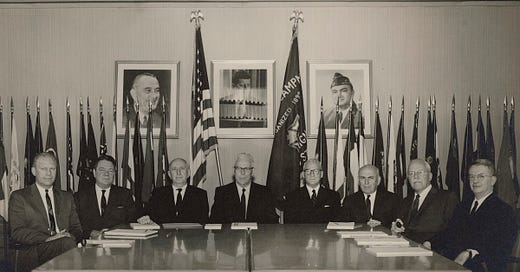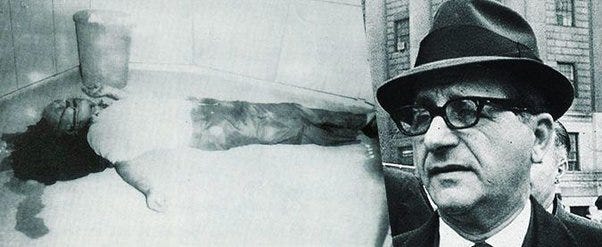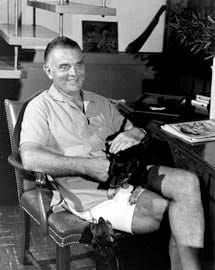The Red River Brief (The Wrong Brother): Part VI
Conclusions both correct and, for the time being, partially erroneous.
As mentioned previously, the identity of the shooters and spotters is superfluous to what truly matters: who organized the planning, who paid for it, and how it was executed. The names of Corsican hit men, Cuban exiles, and Nazi sharpshooters are part of the problem: researchers focus on them instead of all of the steps that led to them.
A logical question to ask is why Nixon seemingly gets a pass historically for connections to the JFK plot, despite his deep connections to so many of the alleged conspirators, while hundreds of others names with lower degrees of connections are routinely mentioned.
To repeat our earlier query, it is wise to ask again what Nixon, Ford, Bush, Hunt, Sturgis, Shackley, Jenkins, Roselli, Ruby, and Oswald were ALL doing in Dallas on the same day that JFK was assassinated?
And the fact that four future US Presidents were in the same city at the same time when the current President was killed is surely one of the more implausible coincidences ever detailed relating to the assassination of a nation’s leader. Even the group murder of Julius Caesar in 44 BC had less future emperors in attendance.
At least Ruby and Oswald each had a plausible reason: they were Dallas residents.
But is it not odd that Nixon, who had been narrowly defeated by JFK in the 1960 election, would be in the same Texas city as his benefactor Prescott Bush’s son—CIA agent George H.W. Bush—along with four other CIA agents (Hunt, Sturgis, Shackley, Jenkins)? Or that two of those four would later be on his team of White House plumbers tasked with breaking into the headquarters of the Democratic National Committee in the Watergate Building?
And why would Johnny Roselli, a man who reported directly to a mob boss being investigated by Attorney General Robert F. Kennedy—but also with ties directly to the CIA and Cuban exile activities—just happen to be in Dallas that day as well?
Finally, what are the odds that Ruby—the assassin of the alleged JFK assassin (see The Murder of Admiral Darlan by Alick de Montmorency)—would be connected to both Nixon and Marcello? Is it also not a conundrum that the only person Ruby wished to contact while detained in Dallas prior to his trial was local restauranteur Joe Campisi, an alleged organized crime figure with family ties to Shreveport, the Maroun brothers, Carl Elmer Jenkins, and Carlos Marcello?
This brief has not definitively proved anything with these various connections because there is no direct testimony from any of the purported actors, nor will there ever be since they are all deceased, but when the connections and facts are laid out purposefully and concisely as they are here, do they not raise at least the most minimal of objective doubts about every single theory prescribed by JFK assassination experts for almost 58 years?
Biases can be impossible to overcome when a writer or researcher believes a conclusion to be true before it is actually proven to be true with evidence and repeated deductive reasoning. And, of course, books and articles and documentaries may also be influenced by nefarious funding sources intent on creating a particular position to influence the impressions and beliefs of readers/viewers away from the actual evildoers.
As a result, since November 1963, anyone with even a passing interest in the JFK assassination plot and its conspirators has been overwhelmed by a continuous stream of accusations from all directions that lead nowhere and compound the confusion.
In fact, it is often more satisfying to dismiss the insurmountable mass of information regarding the assassination conspiracy by doing one of three things: (1) seeking a simple answer to the death of JFK that brings peace of mind i.e. Lee Harvey Oswald's acting alone because he was a confused and misguided madman; (2) claiming that it would be impossible for hundreds of conspirators to organize the shooting and keep it a secret, thus maintaining the position that it had to be a lone gunman; or (3) pointing to one or several cabal-like elements working in concert to assassinate JFK without coherently connecting the dots of those factions, therefore surrendering to the idea that the massive plot's puzzle is too difficult to solve and, in some cases, better left as a romantic mystery.
But, as mentioned before, could ten or fifteen people involved with the JFK plot keep a secret? Could those ten or fifteen people hire professional tradesmen (read shooters and spotters) to do a job and vanish? Could those people silence a patsy? And could those same people change history in a way that would directly benefit and enrich their families and friends with generational wealth as a result of doctrinal changes to include war profiteering in Vietnam?
And, later, if several of those ten to fifteen people were facing prosecution by the government—a government they themselves had helped create by assassinating a chief executive years earlier who stood in opposition to their aims—would it not be plausible for those plotters to be silenced themselves?
Let us return to expanded Aristotelian models to conclude with two proofs through correlative tracking:
Prescott Bush knew Nixon.
Prescott Bush's son George H.W. Bush was chairman of the Republican National Committee under Nixon.
Jack Ruby knew Nixon.
Jack Ruby knew Carlos Marcello.
Nixon was the mouthpiece for Allan Dulles in Congress.
Allen Dulles was Director of Central Intelligence under JFK.
JFK fired Allen Dulles.
Allen Dulles was a member of the Warren Commission with Gerald Ford.
E. Howard Hunt, Frank Sturgis, Ted Shackley, Carl Elmer Jenkins, and George H.W. Bush were CIA agents involved with the Bay of Pigs.
E. Howard Hunt and Frank Sturgis were involved with the Watergate burglary under Nixon.
George H.W. Bush was Director of Central Intelligence under Ford.
Ford pardoned Nixon.
—
Why was JFK assassinated?
It’s actually rather simple.
Greed and power.
Most importantly, the threats to both by the JFK administration and its policies. Let us examine what happened in the aftermath of 11/22/63:
1. The continuation of the old guard at the CIA controlling all aspects of intelligence.
2. The advancement of cold war foreign policy methodologies to enrich the military industrial complex.
3. The billions of dollars in profits for the heads of the military industrial complex and the bankers who managed their portfolios as a result of those methodologies.
4. The resignation of RFK as Attorney General and the cessation of Justice Department investigations into organized crime.
5. The enforcement of a lone gunman explanation to mislead the public and protect the identities of the conspirators.
The beauty of the lone gunman theory, of course, is that in addition to bamboozling the American public it also created the Dulles-labelled conspiracy theorists who—because of their vigor to discover the truth with a limited amount of access to information—actually helped protect the identities of the conspirators due to their outlandish conclusions, the naming of hundreds of peripheral figures who may or may not have had connections to the plot conspirators, and their egotistical desires to be the first person to solve the case. Thus, journalists who were incorrect in their assertions and conclusions actually legitimized others accusing them of being conspiracy theorists! The playbook for the silenced, lone gunman story was the assassination of Admiral Darlan as documented by Alick de Montmorency.
Marginalizing dissenters who disagreed with the findings of The Warren Commission became easier and easier as time moved forward and more and more absurd theories were presented. The true conspirators were thus insulated without having to do any further damage control on their own, other than the occasional murder of potential witnesses to their crimes.
Of note:
Sam Giancana (see photo below) was murdered on 6/19/75 before he was scheduled to testify before the Select Committee to Study Governmental Operations with Respect to Intelligence Activities. This committee investigated alleged abuses of power by the CIA and FBI and is commonly known as The Church Committee after its chairperson, Senator Frank Church (R-ID).
In another bizarre twist of fate, the second Congressional relief act for Alick de Montmorency five years later in 1980 was sponsored by Rep. George V. Hansen, a Republican from Idaho just like Senator Church.
Johnny Roselli disappeared 7/28/76 before he was scheduled to testify before the United States House of Representatives Select Committee on Assassinations (HSCA) 1976-1978. His dismembered body was found a few weeks later in an oil drum floating off the Florida coast (see actual photo below).
George De Mohrenschildt committed suicide on 3/29/77 before he was scheduled to testify before the HSCA.
Society often pokes fun at the mysterious deaths and disappearances of figures closely connected to fiercely-debated historical events with a bizarre and almost macabre ambivalence, but there is actually nothing funny about these losses considering both their interlocking connections to the JFK plot and the timing of their demises.






